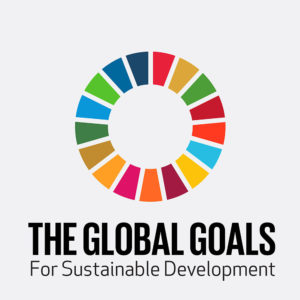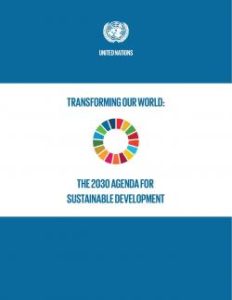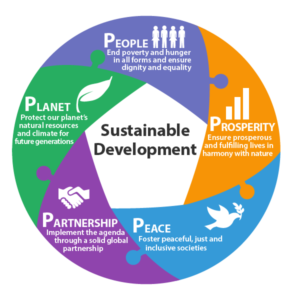 The UN Sustainable Development Goals
The UN Sustainable Development Goals
The United Nations Sustainable Development Goals (UN SDGS or Global Goals) are part of an agenda for sustainable development which was adopted by the General Assembly of the United Nations in 2015. The Agenda is outlined in the document “Transforming Our World: The 2030 Agenda for Sustainable Development” A/RES/70/1. The document includes 17 Sustainable Development Goals, each having its own specific targets: a complete list of the goals is provided below.
Agenda 2030
The Agenda is a “plan of action for people, planet and prosperity which seeks to strengthen universal peace in larger freedom”. The goals and targets are intended to “stimulate action over the next 15 yeas in areas of critical importance for humanity and the planet” and to establish sites of partnership for collaborative engagement and action. The Global Goals are universal, integrated and indivisible; and balance the three dimensions of sustainable development: the social, the environmental and the economic. The FIVE P’s of AGENDA 2030 can also be understood as a five dimensional model of sustainable development.
The ‘Five Ps’ model of Sustainable Development
Planet: the environmental dimension.
Prosperity: the economic dimension.
Two other important elements of the conception of sustainability underpinning the Agenda are:
Peace and Partnership
Peace constitutes a fourth dimension of sustainable development: the ethical dimension, which concerns ideals and values such as equality, freedom, human dignity and justice.
Partnership describes the collective and collaborative approach required to implement the goals and achieve the universal engagement that is essential for the success of the Agenda’s ultimate aim: to transform the world.
Some of the main focal points of the Agenda are:
-
- overcoming poverty;
- addressing the needs of the poorest and most vulnerable;
- realising human rights and dignity and equality for all (with an emphasis on women and girls; disadvantaged or vulnerable groups);
- healing and securing the planet;
- taking urgent action of climate change;
- seeking technological/economic progress in harmony with nature; and
- and promoting peaceful and inclusive societies.
The Seventeen Sustainable Development Goals
![]()
1 – No Poverty – End poverty in all its forms everywhere
2 – Zero Hunger – End hunger, achieve food security and improved nutrition, and promote sustainable agriculture
3. – Good Health and Well-being – Ensure healthy lives and promote well-being for all at all ages
4 – Quality Education – Ensure inclusive and equitable quality education and promote lifelong learning opportunities for all
5 – Gender Equality – Achieve gender equality and empower all women and girls
6 – Clean Water and Sanitation – Ensure availability and sustainable management of water and sanitation for all
7 – Affordable and Clean Energy – Ensure access to affordable, reliable, sustainable and modern energy for all
8 – Decent Work and Economic Growth – Promote sustained, inclusive and sustainable economic growth, full and productive employment, and decent work for all
9 – Industry, Innovation and Infrastructure -Build resilient infrastructure, promote inclusive and sustainable industrialisation, and foster innovation
10 – Reduced Inequalities – Reduce inequality within and among countries
11 – Sustainable Cities and Communities – Make cities and human settlements inclusive, safe, resilient and sustainable
12 – Responsible Consumption and Production – Ensure sustainable consumption and production patterns
13 – Climate Action – Take urgent action to combat climate change and its impacts
14 – Life Below Water – Conserve and sustainably use the oceans, seas and marine resources for sustainable development
15 – Life on Land – Protect, restore and promote sustainable use of terrestrial ecosystems, sustainably manage forests, combat desertification and halt and reverse land degradation, and halt biodiversity loss
16 – Peace and Justice and Strong Institutions – Promote peaceful and inclusive societies for sustainable development, provide access to justice for all and build effective, accountable and inclusive institutions at all levels
17 – Partnerships for the Goals – Encourage and promote effective public, public-private and civil society partnerships, building on the experience and resourcing strategies of partnerships
INFORMATIVE WEBSITES
Further information about Agenda 2030 and the Sustainable Development Goals is available from the following Websites
UN Sustainable Development – Sustainable Development Goals: http://www.un.org/sustainabledevelopment/sustainable-development-goals/
Contains quite accessible materials, including ‘facts’, targets, and links to other sources of information. The pdfs entitled ‘WHY IT MATTERS’ are a good starting point for introducing students to topics such as ‘Gender Equality’, ‘Water’, ‘Climate Change’, ‘Cities’ and others, with up-to-date information and a focus on the relevance for their lives and the possibility of meaningful action in relation to the issue.
The 17 Goals : Sustainable Development UN Department of Economic and Social Affairs: https://sdgs.un.org/goals
Contains detailed information on each goal, tracking progress, data-sets, targets and implementation.
SDG Transformation Centre: SDG Index: http://www.sdgindex.org/
The SDG Index provides a report card for country performance on the historic Agenda 2030 and the Sustainable Development Goals (SDGs). It is produced by the SDG Transformation Centre, an initiative of the Sustainable Development Solutions Network (SDSN).
SDSN: Sustainable Development Solutions Network: http://unsdsn.org/
“SDSN mobilizes global scientific and technological expertise to promote practical solutions for sustainable development, including the implementation of the Sustainable Development Goals (SDGs) and the Paris Climate Agreement…. SDSN works closely with United Nations agencies, multilateral financing institutions, the private sector, and civil society.”
ALSO
SDSN – AUSTRALIA -PACIFIC: http://ap-unsdsn.org
and SDSN – YOUTH: http://sdsnyouth.org/
